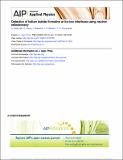Detection of helium bubble formation at fcc-bcc interfaces using neutron reflectometry
Author(s)
Kashinath, A.; Wang, P.; Majewski, J.; Baldwin, J. Kevin; Wang, Y. Q.; Demkowicz, Michael J.; ... Show more Show less
DownloadJApplPhys_114_043505.pdf (2.298Mb)
PUBLISHER_POLICY
Publisher Policy
Article is made available in accordance with the publisher's policy and may be subject to US copyright law. Please refer to the publisher's site for terms of use.
Terms of use
Metadata
Show full item recordAbstract
We use neutron reflectometry to find the critical helium (He) fluence required to form He bubbles at interfaces between fcc and bcc metals. Our findings are in agreement with previous experimental as well as modeling results and provide evidence for the presence of stable He platelets at fcc-bcc interfaces prior to bubble formation. The stable storage of He in interfacial platelets may provide the basis for the design of materials with increased resistance to He-induced degradation.
Date issued
2013-05Department
Massachusetts Institute of Technology. Department of Materials Science and EngineeringJournal
Journal of Applied Physics
Publisher
American Institute of Physics (AIP)
Citation
Kashinath, A., P. Wang, J. Majewski, J. K. Baldwin, Y. Q. Wang, and M. J. Demkowicz. “Detection of Helium Bubble Formation at Fcc-Bcc Interfaces Using Neutron Reflectometry.” Journal of Applied Physics 114, no. 4 (2013): 043505. © 2013 AIP Publishing LLC
Version: Final published version
ISSN
00218979
1089-7550